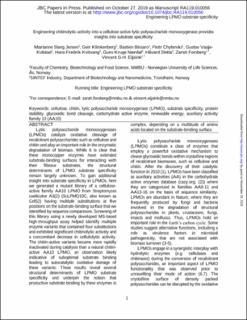| dc.contributor.author | Jensen, Marianne Slang | |
| dc.contributor.author | Klinkenberg, Geir | |
| dc.contributor.author | Bissaro, Bastien | |
| dc.contributor.author | Chylenski, Piotr | |
| dc.contributor.author | Vaaje-Kolstad, Gustav | |
| dc.contributor.author | Kvitvang, Hans Fredrik Nyvold | |
| dc.contributor.author | Nærdal, Guro Kruge | |
| dc.contributor.author | Sletta, Håvard | |
| dc.contributor.author | Forsberg, Zarah | |
| dc.contributor.author | Eijsink, Vincent | |
| dc.date.accessioned | 2020-07-01T09:47:46Z | |
| dc.date.available | 2020-07-01T09:47:46Z | |
| dc.date.created | 2019-11-22T07:43:06Z | |
| dc.date.issued | 2019 | |
| dc.identifier.issn | 0021-9258 | |
| dc.identifier.uri | https://hdl.handle.net/11250/2660269 | |
| dc.description.abstract | Lytic polysaccharide monooxygenases (LPMOs) catalyze oxidative cleavage of recalcitrant polysaccharides such as cellulose and chitin and play an important role in the enzymatic degradation of biomass. While it is clear that these monocopper enzymes have extended substrate-binding surfaces for interacting with their fibrous substrates, the structural determinants of LPMO substrate specificity remain largely unknown. To gain additional insight into substrate specificity in LPMOs, here we generated a mutant library of a cellulose-active family AA10 LPMO from Streptomyces coelicolor A3(2) (ScLPMO10C, also known as CelS2) having multiple substitutions at five positions on the substrate-binding surface that we identified by sequence comparisons. Screening of this library using a newly developed MS-based high-throughput assay helped identify multiple enzyme variants that contained four substitutions and exhibited significant chitinolytic activity and a concomitant decrease in cellulolytic activity. The chitin-active variants became more rapidly inactivated during catalysis than a natural chitin-active AA10 LPMO, an observation likely indicative of suboptimal substrate binding leading to autocatalytic oxidative damage of these variants. These results reveal several structural determinants of LPMO substrate specificity and underpin the notion that productive substrate binding by these enzymes is complex, depending on a multitude of amino acids located on the substrate-binding surface. | en_US |
| dc.language.iso | eng | en_US |
| dc.publisher | American Society for Biochemistry and Molecular Biology | en_US |
| dc.subject | Cellulose | en_US |
| dc.subject | Chitin | en_US |
| dc.subject | Substrate specificity | en_US |
| dc.subject | Protein stability | en_US |
| dc.title | Engineering chitinolytic activity into a cellulose-active lytic polysaccharide monooxygenase provides insights into substrate specificity | en_US |
| dc.type | Journal article | en_US |
| dc.type | Peer reviewed | en_US |
| dc.description.version | publishedVersion | en_US |
| dc.rights.holder | © 2019 Jensen et al.
Published under exclusive license by The American Society for Biochemistry and Molecular Biology, Inc. | en_US |
| dc.source.journal | Journal of Biological Chemistry | en_US |
| dc.identifier.doi | 10.1074/jbc.RA119.010056 | |
| dc.identifier.cristin | 1750765 | |
| dc.relation.project | Norges forskningsråd: 226247 | en_US |
| cristin.unitcode | 7401,80,1,0 | |
| cristin.unitname | Bioteknologi og nanomedisin | |
| cristin.ispublished | true | |
| cristin.fulltext | original | |
| cristin.qualitycode | 2 | |
